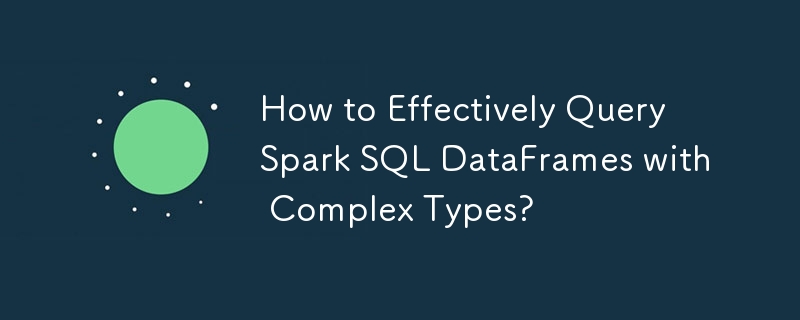Home >Database >Mysql Tutorial >How to Effectively Query Spark SQL DataFrames with Complex Types?
How to Effectively Query Spark SQL DataFrames with Complex Types?
- Patricia ArquetteOriginal
- 2025-01-21 11:26:14794browse

Efficiently Querying Spark SQL DataFrames with Complex Data Types
Working with complex data types like arrays and maps in Spark SQL DataFrames can present unique challenges. This guide outlines effective strategies for retrieving data from these structures.
Querying Array Columns:
Several methods exist for accessing array elements:
-
getItemMethod: Directly access an element using its index. -
Hive Bracket Notation: Use square brackets (
[]) to specify the element's index. - User-Defined Functions (UDFs): Create custom functions for more complex element extraction logic.
-
Higher-Order Functions: Leverage functions like
transformfor element-wise manipulations. -
Built-in Array Functions: Utilize functions such as
array_distinctfor specific array operations.
Accessing Map Columns:
Retrieve map values using these techniques:
-
getFieldMethod: Access a value using its associated key. - Hive Bracket Notation: Directly access values within the query using key-value syntax.
- Dot Notation: Use a fully qualified path to navigate to the desired value.
- UDFs: Employ UDFs for more intricate value retrieval.
-
Map Functions: Utilize functions like
map_keysandmap_valuesfor key and value extraction.
Working with Struct Columns:
Access fields within struct columns using:
- Dot Notation (DataFrame API and SQL): Use period-separated paths to traverse the struct's hierarchy.
Navigating Nested Structures:
Accessing fields within nested arrays or structs involves:
- Dot Notation: Chain periods to access nested fields.
-
getItemMethod: Extract array elements using their indices. - UDFs: Define UDFs for handling complex nested access patterns.
Handling User-Defined Types (UDTs) and Nested Values:
- UDFs for UDT Access: Use UDFs to query fields of user-defined types.
- Schema Flattening and Exploding: Consider restructuring your schema by flattening or exploding collections to simplify queries.
Additional Considerations:
- Depending on your Spark version,
HiveContextmay be necessary for certain operations. - Wildcard characters can be incorporated into dot notation for flexible field selection.
- Specialized functions like
get_json_objectandfrom_jsonare available for querying JSON columns.
The above is the detailed content of How to Effectively Query Spark SQL DataFrames with Complex Types?. For more information, please follow other related articles on the PHP Chinese website!

